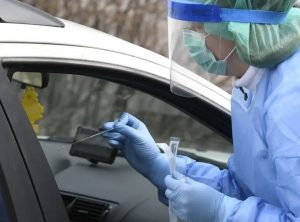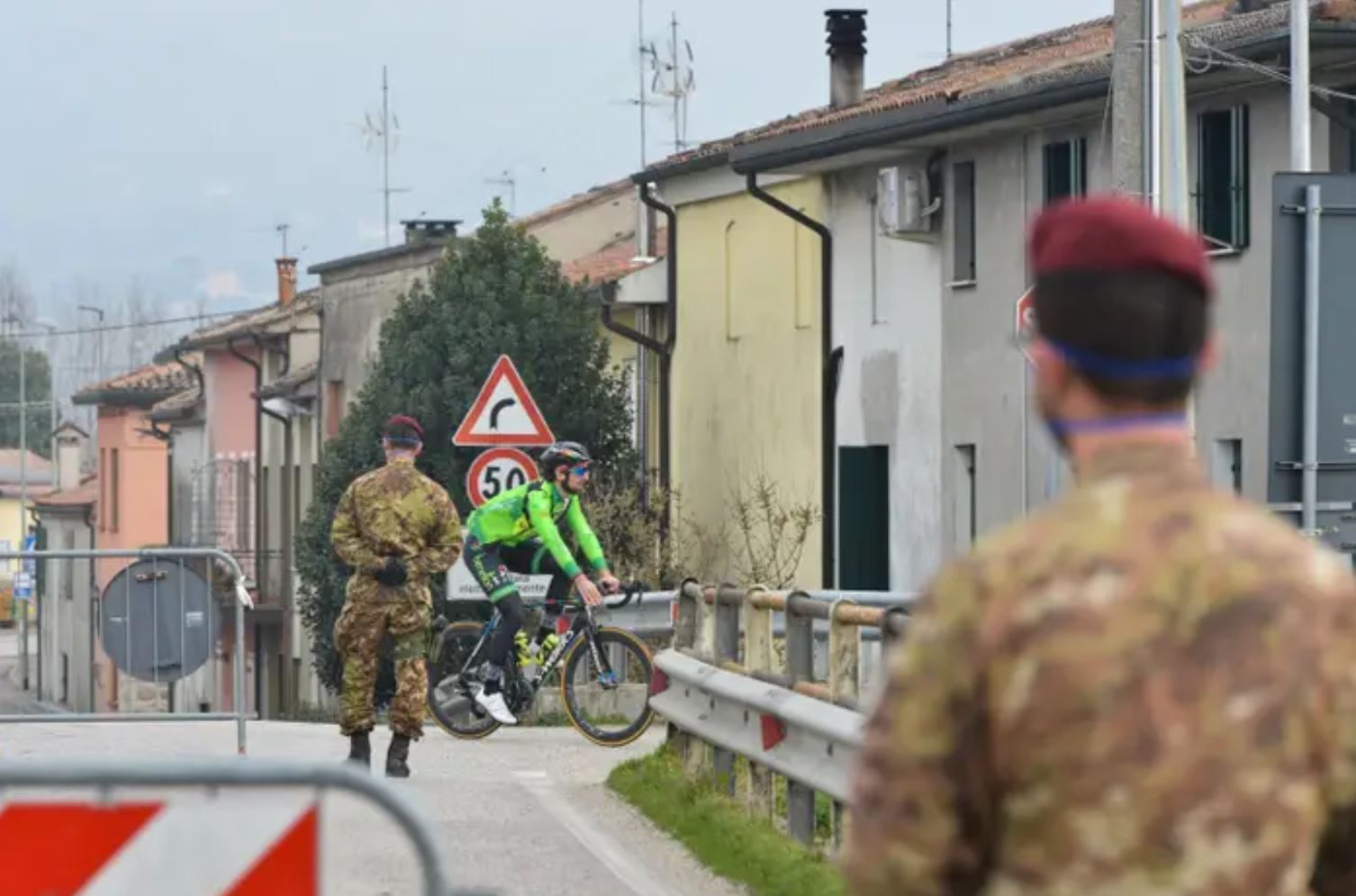Marco Sabadin / Getty Images
Italian soldiers patrol by a checkpoint at the entrance of the small town of Vo Euganeo, situated in the red zone of the coronavirus outbreak in northern Italy.
Mass testing on the scale adopted in Iceland is unlikely to be feasible across larger countries. However, it has proved crucial in some of the other areas hardest hit by the novel coronavirus so far. The testing has provided evidence revealing that a significant portion of those who catch the disease do so with no or mild symptoms — and confirmed multiple pieces of research that have shown that asymptomatic individuals contribute to the transmission of the disease in great numbers.
In the small northern Italian town of Vo, one of the communities where the outbreak first emerged, the entire population of 3,300 people was tested — 3% of residents tested positive, and of these, the majority had no symptoms, researchers said.
The population was tested again after a two-week lockdown and isolation. Researchers found that transmission was reduced by 90% and all those still positive were without symptoms and could remain quarantined.
Luca Zaia, the governor of the Veneto region told Italian media this week: “We tested everyone, even if the ‘experts’ told us this was a mistake: 3,000 tests. We found 66 positives, who we isolated for 14 days, and after that 6 of them were still positive. And that is how we ended it.”
Zaia wants to now extend mass testing, which started as a contingency measure in Vo, to the whole region. The Veneto governor told newspaper Corriere della Sera that the region has the ability to carry out 20-25,000 swabs a day.
The initial data from Iceland and Veneto appears to be in line with authoritative studies that have attempted to model the novel coronavirus.

Heikki Saukkomaa / Getty Images
A person wearing protective clothes takes samples from people arriving in their cars at a testing drive-in station in Espoo, Finland.
A study published on Monday in the magazine Science found that for every confirmed case of the virus there are likely another five to 10 people with undetected infections in the community. The scientists, which based their model on data from China, reported that these often milder and less infectious cases are behind nearly 80% of new cases.
Another report published this week by the Imperial College COVID-19 Response Team — a group of experts who have been advising the British and other European governments on how the disease could spread — makes a similar case.
It states: “Analyses of data from China as well as data from those returning on repatriation flights suggest that 40-50% of infections were not identified as cases. This may include asymptomatic infections, mild disease and a level of under-ascertainment.” The model also assumes that infectiousness occurs more quickly in symptomatic individuals and that they are more infectious than asymptomatic ones.
The finite testing capacity available to governments is mostly focussed on testing those symptoms and tracing their contacts, while other measures to slow the virus and not overwhelm health services cover the population at large.
But the volume of testing has become a critical issue as the virus has spread to countries around the world and new cases are growing exponentially across much of western Europe.
The World Health Organization has urged countries to test more suspected cases. “You cannot fight the fire blindfolded, and we cannot stop this pandemic if we don’t know who is infected,” director-general Dr Tedros Adhanom Ghebreyesus said this week. “We have a simple message for all countries: Test, test, test. Test every suspected case.”
And the governments fighting back against the coronavirus say that extensive testing has led to substantial results — and saved lives.

Ed Jones / Getty Images
A woman watches from a waiting area as a nurse administers a COVID-19 novel coronavirus test at a testing booth outside Yangji hospital in Seoul, March 17. A South Korean hospital has introduced phone booth–style coronavirus testing facilities that avoid medical staff having to touch patients directly and cut down disinfection times.
South Korea, one of the countries first and worst hit after China, quickly put in place the most aggressive testing regime in the world after a cluster of a few dozen cases in early February exponentially ballooned to almost 5,000 cases by the end of that month. The country now has the ability to test about 20,000 people a day. A diagnosis takes about five to six hours and patients usually get results within a day. 268,000 South Koreans have been tested for the virus — about one in every 200 citizens, according to South Korean foreign minister Kang Kyung-wha.
After surpassing 8,000 cases, the number of new cases is now smaller than the number of those fully cured. The South Korean foreign minister told the BBC that testing was key. “Testing is central because that leads to early detection, it minimises further spread and it quickly treats those found with the virus,” she said. “That is the key behind our very low fatality rate as well.”
The data from South Korea is in stark contrast to countries like the UK, where there is currently no community testing of people with symptoms self-isolating at home. The government is under mounting pressure to do more.
Although Britain has carried out more tests when compared to many others around the world it is still lagging well behind the likes of South Korea and Italy, which as of March 17 had carried out 148,657 tests. Yesterday that figure stood at just under 138,000 and five days ago it was 86,000.
As of 9am on Tuesday, a total of 50,442 tests had been carried out in the UK, with 1,950 positive results and 48,492 negative. Health secretary Matt Hancock tweeted that a record 7,500 tests had been done in the past 24 hours.
The actual number of cases in the UK was estimated on Monday to be between 35,000 and 50,000, with this number expected to grow rapidly in the coming weeks.
This week the UK government shifted to a strategy to “suppress” the outbreak and scaling up testing could prove challenging. There has been growing criticism of its approach on testing; as the number of cases soars, people with mild symptoms are now being advised to stay at home without being tested. It means that many coronavirus sufferers will never know for sure whether or not they had it.
At the moment, testing is largely restricted to all those in intensive care units, and those with pneumonia or significant respiratory infections in hospital. This is because there is limited testing capability, according to the government scientists, which must be directed to the most serious patients where doctors need to make decisions based on clinical need.
On Tuesday, the government’s chief scientific adviser Patrick Vallance told the Commons health select committee that he had been “pushing for” a “big increase in testing” in the UK.
He said there was a lot of work going on within Public Health England, the NHS and the Department of Health and Social Care to select a test that could be used more widely in the community.
The government should work closely with the private sector, he added, so “we can get things out there faster on the community side”.
There are also deep concerns among NHS workers that they are not getting the tests they need, amid fears that they are unwittingly spreading the virus to vulnerable patients.
Doctors and nurses, as well as frontline health and emergency personnel, in China and Italy are among the many that have died from the disease.
類型: 文章
作者: Alberto Nardelli,Emily Ashton
出處: BuzzFeed News
連結: https://www.buzzfeed.com/albertonardelli/coronavirus-testing-iceland

